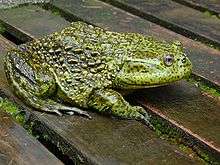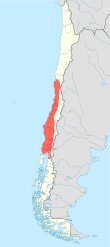Helmeted water toad
| Helmeted water toad | |
|---|---|
 | |
| Scientific classification | |
| Kingdom: | Animalia |
| Phylum: | Chordata |
| Subphylum: | Vertebrata |
| Class: | Amphibia |
| Subclass: | Lissamphibia |
| Order: | Anura |
| Suborder: | Neobatrachia |
| Family: | Calyptocephalellidae |
| Genus: | Calyptocephalella Strand, 1928 |
| Species: | C. gayi |
| Binomial name | |
| Calyptocephalella gayi (Duméril & Bibron, 1841) | |
 | |
| Range in red | |
| Synonyms | |
|
Caudiverba caudiverba | |
The helmeted water toad, Chilean helmeted bull frog or wide-mouth toad (Calyptocephalella gayi, syn. Caudiverba caudiverba) is the sole species of the genus Calyptocephalella in the family Calyptocephalellidae. The only other members of this family are Telmatobufo. The helmeted water toad is found in central Chile, and possibly adjacent west-central Argentina. This very large toad weighs up to 0.5 kg (1.1 lb). It is aquatic and found in deep ponds and small reservoirs. It is threatened by capture for human consumption, habitat loss, pollution, and introduced trout. It is occasionally captured for herpetoculture.
Characteristics
This very large species can reach a snout–to-vent length of up to 12 cm (4.7 in) in males and 32 cm (13 in) in females.[2] The maximum weight is 0.5 kg (1.1 lb).[3] The tadpoles are also unusually large at up to 15 cm (5.9 in) long.[2] These toads are colored yellow, brown, and green, with light green in mature specimens, while the oldest are gray, or have gray patches on a dark background.
Reproduction
The female lays eggs in water bodies containing abundant vegetation. Larval life lasts about two years. After hatching, larval survival depends on the presence of vegetation as the existence of movements in the body of water maintain good oxygenation, but the presence of seasonal ponds with some degree of drainage is essential for hatching, as these sites contain fewer predators to the larvae. Then, the transport of larvae from ponds, to larger bodies of water during the rains, or transport of these among several bodies of water facilitates the survival and allows a good development of populations. The larvae prefer cooler areas of the body of water and protective aquatic vegetation, unlike toad larvae that occupy the same sites and have a higher degree of pigmentation that protects them from the solar rays.
Feeding
Their food in the larval stage is vegetation. In adult form, they vary their diets to live animal prey, feeding on fish, invertebrates, birds, and small rodents, and even cannibalism.
State of conservation
It is a vulnerable species according to IUCN due to capture for human consumption, habitat loss, pollution, and introduced trout.[1] It is also threatened by the introduction of the African clawed frog (Xenopus laevis; known in Chile as the African toad), a species that has affected, as in other parts of the world, local amphibians when carrying the chytrid fungus Batrachochytrium dendrobatidis, which passes through the skin of amphibians not adapted to it. Their cells react to the pathogen, causing hardening and, therefore, hyperkeratosis and death by asphyxiation. The fungus has been classified as a major factor in the decline in amphibian populations worldwide, but in Chile has been reported recently, in 2009. Other causes cited are competition that occurs between X. laevis and Chilean frog, introduced for sale in the market for frog legs.
References
- 1 2 Calyptocephalella gayi 2006 IUCN Red List of Threatened Species. Downloaded on 3 January 2011.
- 1 2 AmphibiaWeb: Calyptocephalella gayi. Retrieved 21 March 2015.
- ↑ Toledo; Suazo; and Viana (2014). Formulated diets for giant Chilean frog Calyptocephalella gayi tadpoles. Cien. Inv. Agr. 41(1): 13-20.
- Panama Amphibian Rescue and Conservation Project: Workshop in Chile targets the protection of the Helmeted Water Toad
- Vidal and Labra (2008). Herpetología de Chile. ISBN 978-956-319-420-3
